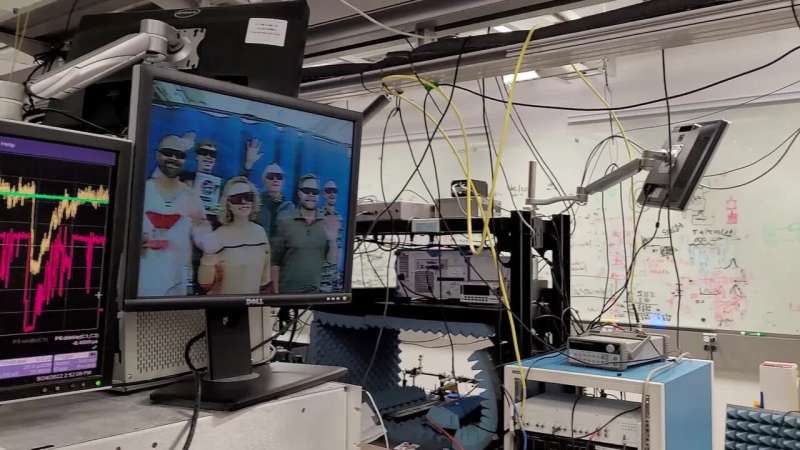Atom-based radio receiver detects and displays live color television and video games

Researchers at the National Institute of Standards and Technology (NIST) have adapted their atom-based radio receiver to detect and display live color television and video games.
Atom-based communications systems are of practical interest because they could be physically smaller and more tolerant of noisy environments than conventional electronics. Adding video capability could enhance radio systems in, for example, remote locations or emergency situations.
NIST’s receiver uses atoms prepared in high-energy “Rydberg” states, which are unusually sensitive to electromagnetic fields, including radio signals. These sensors also enable signal power measurements linked to the international system of units (SI). The latest work, described in AVS Quantum Science, is the first to demonstrate video reception.
“We figured out how to stream and receive videos through the Rydberg atom sensors,” project leader Chris Holloway said. “Now we are doing video streaming and quantum gaming, streaming video games through the atoms. We basically encoded the video game onto a signal and detected it with the atoms. The output is fed directly into the TV.”
Researchers use two different color lasers to prepare gaseous rubidium atoms in Rydberg states in a glass container. The team previously used the setup with cesium atoms to demonstrate the basic radio receiver and a “headphone” appliance to boost sensitivity a hundredfold.
To prepare to receive video, a stable radio signal is applied to the glass container filled with atoms. The team can detect energy shifts in the Rydberg atoms that modulate this carrier signal. The modulated output is then fed to a television. An analog-to-digital converter transforms the signal into a video graphics array format for display.
To display a live video signal or video game, this input is sent from a video camera to modulate the original carrier signal, which is then fed to a horn antenna directing the transmission to the atoms. Researchers use the original carrier signal as a reference and compare it to the final video output detected through the atoms to evaluate the system.
The researchers studied the laser beam sizes, powers and detection methods required for the atoms to receive video in standard definition format. The beam size affects the average time the atoms remain in the laser interaction zone. This time is inversely related to the bandwidth of the receiver; that is, a shorter time and smaller beam produce more data. That’s because atoms move in and out of the interaction zone, so smaller areas result in a higher signal “refresh rate” and better resolution.
Researchers found that small beam diameters (less than 100 micrometers) for both lasers led to much faster responses and color reception. The system achieved a data rate on the order of 100 megabits per second, considered an excellent speed for video gaming and household internet. Research is ongoing to increase the system’s bandwidth and data rates.
Nikunjkumar Prajapati et al, TV and video game streaming with a quantum receiver: A study on a Rydberg atom-based receiver’s bandwidth and reception clarity, AVS Quantum Science (2022). DOI: 10.1116/5.0098057
Citation:
Atom-based radio receiver detects and displays live color television and video games (2022, August 18)
retrieved 18 August 2022
from https://techxplore.com/news/2022-08-atom-based-radio-television-video-games.html
This document is subject to copyright. Apart from any fair dealing for the purpose of private study or research, no
part may be reproduced without the written permission. The content is provided for information purposes only.
For all the latest Technology News Click Here
For the latest news and updates, follow us on Google News.
